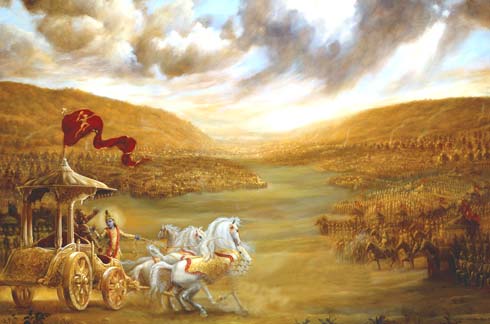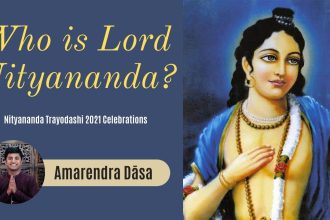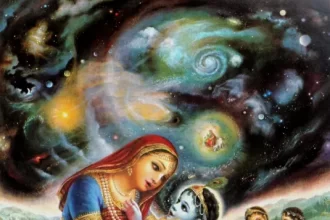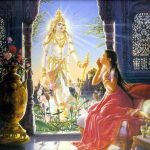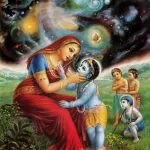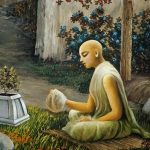Praying to Ganeshji for MATERIAL advancement deepens your materialistic bonds and does not free you for attaining the highest perfection of human life, namely service to the Supreme Lord Krishna & a devotee worships Lord Ganesh in order to have their path towards devotional service to Sri Sri Radha and Krishna cleared of all impediments.
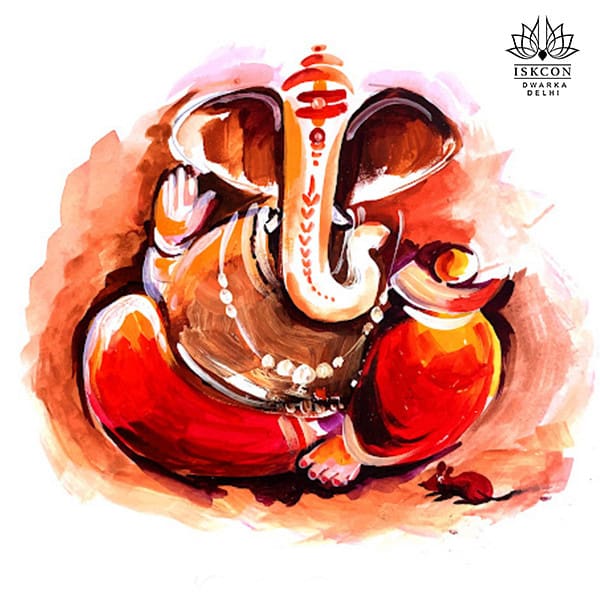
In the ‘Brahma Samhita’ it is stated that Lord Ganesha derives his powers to destroy all impediments by worshiping the lotus feet of Lord Narasimhadeva (the form of Krishna who killed the demon Hiranyakashipu).
It is recommended in the ‘Bhakti rasamrita sindhu’ written by Srila Rupa Goswami (one of the great Vaishnava acharyas) that all devotees should worship Lord Ganesh in order to have their path towards devotional service to Sri Sri Radha and Krishna cleared of all impediments.
Prabhupada on Ganesha Wordhip
71-08-25 Letter: Sivananda
So far worshiping Ganesa is concerned, that is not necessary. Not that it should be done on a regular basis. If you like you can pray to Ganapati for removing all impediments on the path of Krishna Consciousness. That you can do if you like.
74-11-21 Letter: Sudama
The Ganesa puja may not be performed. No, it is not to be done. No need of it.
74-12-28 Letter: Sons
Krsna says in the Bhagavad-Gia, chapter 18; sarva-dharman parityajya, mam ekam saranam vraja, aham tvam sarva-papebhyo, moksayisyami ma sucah. So why you want to worship someone else. Krsna, Himself, recommends mam ekam, he alone. Therefore we must do like that. If one wants to water the tree he waters the root. There is no necessity of watering the branches. The demigods are all different parts of the universal form of the Supreme Lord. But Krsna is even more than that whole complete universal form. He is the origin of that universal form. Therefore I do not encourage you to worship this demigod, Ganesa. It is not required, it is not necessary. Simply worship Krsna. Perform nice devotional service to Krsna. Then your lives will certainly become perfect. Of course if one has got some sentiment for achieving the blessings of Ganesa for accumulating large sums of money to serve Krsna, then he may perform this Ganesa worship, privately, not making a public show.
74-12-31 Letter: Gurukrpa
Regarding Ganesa Puja, I have received some letters from persons requesting to also perform it. I have explained to them that ultimately it is not required, but if you have some sentiment to get the blessings of Ganesa in order to get huge sums of money for service of Krishna, then it can be done, but privately.
General Description
The principal scriptures dedicated to Ganesha are the Ganesha Purana, the Mudgala Purana, and the Ganapati Atharvashirsa. Brahma Purana and Brahmanda Purana are other two Puranic texts that deal with Ganesha.
Lord Ganesh is known as the son of the Shiva and Parvati, and is the god of luck and of “opening the way.” That is why many people pray to Ganesh before starting a new project, in order to proceed with as few obstacles as possible.
Ganesha became the Lord (Isha) of all existing beings (Ganas) after winning a contest from his brother Kartikaya. When given the task to race around the universe, Ganesha did not start the race like Kartikeya did, but Ganesh simply walked around Shiva and Parvati, both his father and mother, as the source of all existence, and, thus, showed his intelligence.
The most prominent characteristic of Lord Ganesh is that he has the head of an elephant. How Lord Ganesh got an elephant’s head is related in several places in the Vedic texts. There may be a few different versions, but the general way in which it is accepted relates as follows: One day Goddess Parvati was at home on Mt. Kailash preparing for a bath. As she didn’t want to be disturbed, she told Nandi, her husband Shiva’s Bull carrier, to guard the door and let no one pass. Nandi faithfully took his post, intending to carry out Parvati’s wishes. But, when Shiva came home and naturally wanted to come inside, Nandi had to let him pass, being loyal first to Shiva. Parvati was angry at this slight, but even more than this, at the fact that she had no one as loyal to Herself as Nandi was to Shiva. So, taking the turmeric paste (for bathing) from her body(some say it was sandalwood paste) and mixing it and fashioning it into her son, she breathed life into it and she created Ganesha who manifested from this form, declaring him to be her own loyal son.
Then when Lord Shiva’s wife, Parvati, was going to bathe in the forest, she wanted someone to guard the area. Some references say she was going to bathe in her house. So she ordered Ganesh to let no one into the area while she was bathing. However, Lord Shiva came after a long absence and wanted in, but was blocked by Ganesh. Lord Shiva did not recognize the boy as his son, nor did Ganesh realize Shiva was his father, and enraged, Shiva and Ganesh began to fight. Ganesh lost the battle with his head being cut off. When Parvati entered the scene and saw what had happened, she was so upset that she was thrown into despair and threatened to destroy the entire universe. Shiva, after understanding the situation, devised the means to revive his son. Desperate to pacify her, Shiva promised to take the head of the first creature he came upon in order to give their son a new head and bring him back to life, and that first being was an elephant. So Ganesh got the head of an elephant and with Lord Shiva’s power, came back to life.
Part of the meaning behind this symbolism of the man with an elephant’s head is to represent the unity between the small entity, or man, and the large universe, the elephant. In the word “gaja”, which means elephant, “ga” means the goal, and “ja” means the origin. In the form of Ganesh, the elephant-headed man represents the culmination of the man, the origin, on the path toward universal consciousness, the goal. Ganesh, therefore, is the representation of man who understands the foundation of the reality upon which the universe rests, as is summarized in the Vedic term, “Thou art That,” tat tvam asi. (Taittiriya Aranyaka 8.1.1)
THE SYMBOLOGY OF GANESH
Ganesh is also called Ganapati. This means lord of the Ganas who are the attendants who control the function of the sense organs. According to Karapatri’s Sri Bhagavat-tattva (p. 638), the word gana means a collection of something that can be counted or comprehended. In this way, Ganapati is also the lord or ruler of categories.
He is also known as the Lord of thresholds or entrances into new dimensions. He is the remover of obstacles or obstructions. That is why students pray to Ganesh before taking a major test, to remove the obstacles. That is also why it is not unusual, especially in India, that as we enter a new space or house we may see an image of Ganesh above the door or nearby to give blessings to those who enter. Thus, he is also the guardian of the doorways. This is the case in many Vedic temples. As we enter the temple, we first see a deity of Ganesh to whom we pray for blessings and the removal of obstacles in our devotion or the rituals that we do inside the temple. That way the obstacles to our worship and further spiritual progress can be removed, in which case our spiritual development can be made more rapidly and easily.
Ganesh is also considered the Lord of astrology. He is said to know the language of the stars and the destinies of every living being. Thus, astrologers also petition Ganesh to pen such knowledge to them.
Ganesh is also said to be the writer of the scriptures. (Mahabharata 1.1.77) He accepted the position of being Vyasadeva’s scribe and wrote the Mahabharata andSrimad-Bhagavatam as it was dictated by Srila Vyasadeva, the compiler of the major portions of the Vedic texts. You can see the cave where this is said to have happened at Mana, near the holy place of Badrinatha (Badarikashrama). For this reason the ancient Brahmana texts also describe him as the god of learning.
His other names include Ganesh (related to the word gana), Vinayaka (a name familiar in South India, meaning great leader), Vighneshvara (the remover of obstacles), Gajanana (elephant-faced), Gajadhipa (lord of elephants), and Jyeshtha-raja (King of the elders).
Ganesh is said to have two wives, Siddhi (success) and Riddhi (prosperity). Thus, if anyone pleases Lord Ganesh with nice prayers or worship, the person also attains the company or blessings of the wives of Lord Ganesh. However, if used improperly, success and prosperity can be distractions on the path toward the goal of spiritual wisdom.
Ganesh is also shown in particular ways with certain symbols, which is described in the Ganapati Upanishad (11-14). He is seen with one tusk and four hands, two of which hold a noose and a hook. The noose that he holds is to catch delusion, to free one from its affects. The noose also represents attachment that can lead to anger, which hurts us like the goad. The noose or rope is also used to pull his devotees nearer to the Truth and to tie them to the Highest God. The hook or goad indicates his power and helps motivate one towards the goal. Sometimes he is also shown holding an axe, which he uses to cut off the worldly attachments of His devotees, which can thus end the cause of their sorrow.
Of the other two hands, one is positioned in the gestures for giving blessings and assuring fearlessness, and the other is often holding a rice ball. Ganesh’s hand that gives blessings shows that he can grant one’s desires and assures freedom from fear, and that he is beyond the influence of time and space wherein fear exists. In this way, he blesses all and offers protection from all obstacles on their spiritual path in seeking the Supreme. The rice ball he is often seen holding indicates the reward of thesadhana or spiritual practice for his devotees. Ganesh also has a big stomach and large ears. The fat belly of Ganesh indicates that the influence of the material manifestation is within him. His big ears represent that he accepts the truthful and positive vibrations, while throwing out the false and non-virtuous words that men may present to him. On his flag is a mouse, which is also his carrier.
Deities of Ganesh are often covered with red vermillion. The significance of the vermillion is that it represents the reddened complexion of one who is absorbed in work, which causes the intensified circulation of blood to all parts of the body. This also produces the skin’s red glow. Ganesh is also the lord of action, so he is often seen smeared with red vermillion. He is also worshiped with red flowers. Since Ganesh works wholeheartedly, he has a strong appetite and is thus offered and enjoys a steady supply of sweets and delicacies.
As Vighneshvara, Lord Ganesh also gives us the gifts that destroy obstacles, restrictions, or hindrances. All obstacles exist in the arena of time and space. Through the access of immortality, or the realization of such, we can overcome the fear that is intrinsic in the arena of temporary time and matter. Thus, Lord Ganesh gives and takes away. He gives us what can take away the hindrances and obstacles that keep us from realizing our true potential. Because of this, Lord Ganesh is often worshiped before starting any new project, or before entering a house or building. This is why he is often placed above doorways through which people enter, or is recognized and afforded respect and worship before accepting a new position, starting a new undertaking, or before beginning a new challenge, like taking a difficult test, so we can reach its completion without hindrance.
In worshiping Ganesh, there are several different mantras from which one can choose that help invoke the energy or mercy of Ganesh. There is also a specific graphic design called a yantra that is also a symbol for Ganesh. The swastika is another graphic design that can be used in representing Ganesh and the good fortune that he can provide. This is also why the swastika is a sign for good fortune.
Locally, you often see Ganesh deities as either individual images or as a bas relief carved from stone or boulders. His trunk is also curved to the right and sometimes to the left. This indicates the ways to get around obstacles to reach the goal. This is an indicator of Ganesh’s ability to master adversities, and is also a symbol for the Ommantra. His trunk also often holds a modaka, a type of sweet. The single tusk he has represents the one Truth, while the broken tusk indicates the imperfections of the ever-changing material world. He lost the broken tusk when Parashurama once arrived at Mount Kailash to see Lord Shiva. However, Shiva was sleeping, so Ganesh did not allow Parashurama to get in. When they started fighting, Ganesh lost one tusk. (Padma Purana)
The broken piece of the tusk was later used as a pen to write the Mahabharata when it had been dictated by Srila Vyasadeva to Ganesh. How Ganesh wrote theMahabharata from the dictates of Srila Vyasadeva is described as follows: Vyasadeva entered into a state of meditation after the death of the Kaurava and Pandava clans, and after the disappearance of Lord Krishna. While the great story of events between the tribes, along with the episodes of the Kuruksetra war, was still in his mind, he wanted to write the epic in the form of a great poem. He went to Brahma for advice regarding a qualified person who could accept his dictation to write the story, and Brahma mentioned Ganesh. When Vyasa thought about Ganesh, he appeared before the sage. However, Ganesh was not so receptive to the idea, so he stipulated that Vyasa dictate it in such a way that Ganesh would never have to put down his pen before it was completed. Vyasadeva countered with the requirement that Ganesh not write down anything before he completely understood the meaning of it. Ganesh was not meant to write anything he did not understand in order that he realize the depths of the meaning, and how to write it in a way that would make the meaning accessible to all humanity. This was agreed, and the Mahabharata was completed within three years. (Mahabharata, Adi Parva, Chapter 1, verses 74-80)
Sometimes Ganesh is shown as Balaganapati in his child form, or Tarunaganapati as a young man. During the popular Ganesh Chaturthi festival, Ganesh is worshiped as Varasiddhi Vinayaka. At other times Ganesh is portrayed as Herambaganapati, with a third eye in between his eyebrows, along with five heads and ten arms. These show an extended view of his various powers, which are represented by what he holds in his hands, which include a lotus, pomegranate, water-pot, an axe, a lute, a sugarcane, ears of paddy, a bow and arrow, a thunderbolt, prayer beads, and a book.
The mouse that accompanies Ganesh is his carrier. The mouse is often seen in pictures eating or stealing the sweets that are piled near Ganesh. The mouse is the desire to enjoy material pleasures and the dangers of the ego. Though the mouse is small, this desire for material happiness, and the driver that motivates one into actions to acquire such pleasure, is like a thief that takes away all that people possess. It steals away one’s life that could be used to acquire the goal of spiritual perfection toward true happiness and liberation. The mouse also represents the mind, which is always active. It takes much weight to keep the mind from going astray. The weight of an elephant, Ganesh, on the mouse represents controlling the mind. Thus, Ganesh rides on this mouse as the controller of material desire and the effects of illusion.


